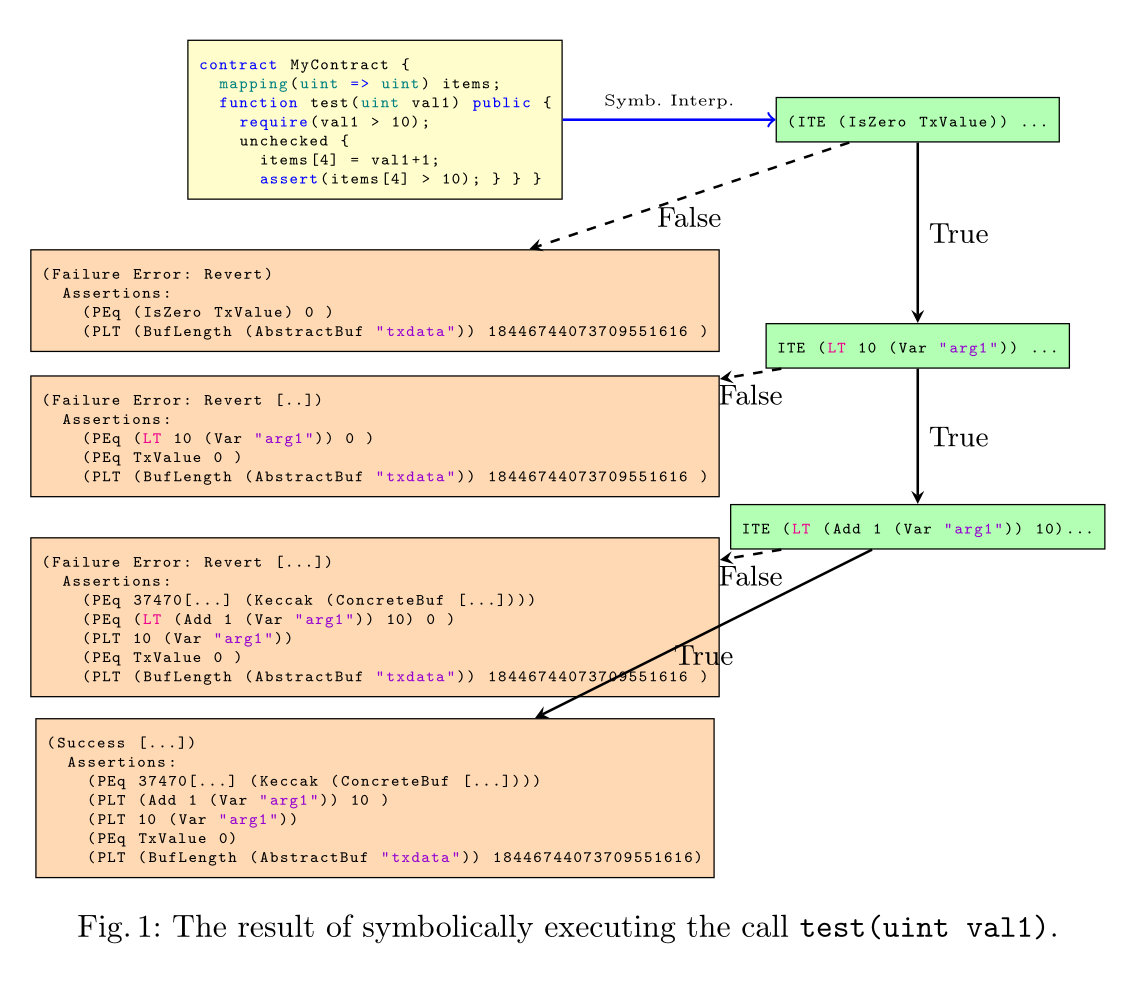Steppers & Interpreters
The core EVM semantics in hevm can be found in EVM.hs. EVM state is contained
in the VM record, and the exec1 function executes a single opcode inside
the monad type EVM a = State VM a.
The core semantics are pure, and should information from the outside world be
required to continue execution (RPC queries or SMT queries),
execution will halt, and the result field of the VM will be an instance of
VMFailure (Query _).
Multiple steps of EVM execution are orchestrated via interpreters for a meta
language. Programs in the meta language are called Steppers. The instructions
in the meta language can be found in Stepper.hs.
There can potentially be many different interpreters with different features. Currently, we provide a concrete and a symbolic interpreter. Interpreters can handle Queries in different ways, for example in the symbolic interpreter, both sides of a branch point will be explored, while in the concrete interpreter, such branching is not permitted.
Interpreters are parametrized by a Fetcher that can handle RPC and SMT
queries, and can be instantiated with fetchers that could have different
fetching strategies (e.g. caching). Interpreters execute Steppers and use their
Fetcher to handle any Queries that need to be resolved.
This architecture is very modular and pluggable, and allows the core semantics to be shared between different interpreters, as well as the reuse of steppers between different interpreters, making it easy to e.g. share the same test execution strategy between concrete and symbolic interpreters.
graph LR
subgraph meta-language
A[Stepper]
end
subgraph interpreters
A --> B[Concrete]
A --> C[Symbolic]
end
subgraph fetchers
F[Fetch.hs]
B --> F
C --> F
end
subgraph EVM Semantics
G[EVM.hs]
B --> G
C --> G
end
Expr
The symbolic execution features in hevm are built using a custom IR,
imaginatively named Expr. This is a summarized trace semantics of a given
EVM program.
One important principle is that of local context: e.g. each term representing a read from a Buf/Storage will always contain a snapshot of the state of the buffer/store at the time the read occurred. This ensures that all context relevant to a given operation is contained within the term that represents that operation, and allows subsequent analysis to be stateless.
Expressions in this language can have the following types:
End: control flowWord: a 256 bit word (a stack item)Byte: a single byteBuf: a byte array (used for calldata, memory and returndata)Storage: contract storageLogs: EVM logs
Control Flow
An EVM program is represented by an [Expr End], which is a list of all
possible end states for a program. As an example the following
two Expr End-s encode a program that branches based on the equality of two symbolic
words ("a" and "b"), and returns if they are equal and reverts if they are not:
[ Success [PEq (Var "a") (Var "b")] ...,
, Failure [PNeg (PEq (Var "a") (Var "b"))] ...]
Buffers
Memory, calldata, and returndata are all represented as a Buf. Semantically speaking a Buf is a byte array with of size 2^256.
Bufs have three base constructors:
- AbstractBuf: all elements are fully abstract values
- ConcreteBuf bs: all elements past (length bs) are zero
Bufs can be read from with:
- ReadByte idx buf: read the byte at idx from buf
- ReadWord idx buf: read the byte at idx from buf
Bufs can be written to with:
- WriteByte idx val buf: write val to idx in buf
- WriteWord idx val buf: write val to idx in buf
- CopySlice srcOffset dstOffset size src dst: overwrite dstOffset -> dstOffset + size in dst with srcOffset -> srcOffset + size from src
e.g. the following Buf expression represents an abi encoded call to foo(uint256 a):
(WriteWord (Lit 0x4) (Var "a")
(WriteByte (Lit 0x3) (LitByte 56)
(WriteByte (Lit 0x2) (LitByte 189)
(WriteByte (Lit 0x1) (LitByte 190)
(WriteByte (Lit 0x0) (LitByte 47)
(AbstractBuf "txdata")))))
This represents calldata of the form:
-----------------------------------------------------------------------
| <function selector> | <symbolic word> | arbitrary symbolic data.... |
-----------------------------------------------------------------------
Note that a Buf expression contains a copy of all historical writes, meaning that it is possible to write multiple times to the same location. In this case only the topmost write is relevant. This allows us to mix symbolic and concrete writes to the same buffer.
Storage
Storage expressions are similar, but instead of writing regions of bytes, we write a word to a particular key in a given addresses storage. Note that as with a Buf, writes can be sequenced on top of concrete, empty and fully abstract starting states.
As with Bufs, Storage expressions contain a full history of all previous writes.
For example the following expression represents a write of a symbolic word "c"
to slot 2 for the zero address followed by a write of 1 to the slot at the
symbolic location "b" for the zero address. These writes are sequenced on top
of an EmptyStore meaning all other storage locations are held to be 0.
(SStore (Lit 0) (Var "b") (Lit 1)
(SStore (Lit 0) (Lit 2) (Var "c")
EmptyStore))
Logs
Logs are also represented as a sequence of writes, but unlike Buf and Storage expressions, Log writes are always sequenced on an empty starting point, and overwriting is not allowed.
Symbolic Execution
During symbolic execution all possible branches of the program are explored symbolically. Reachability analysis is performed at this stage only if needed for loop unrolling. This produces an Expr End. As an example consider the following program:
contract MyContract {
mapping(uint => uint) items;
function test(uint val1) public {
require(val1 > 10);
unchecked {
items[4] = val1+1;
assert(items[4] > 10);
}
}
}
This decompiles into the following Expr End:

For more details, see our research paper on hevm on open access research paper as presented at CAV 2024, presentation here